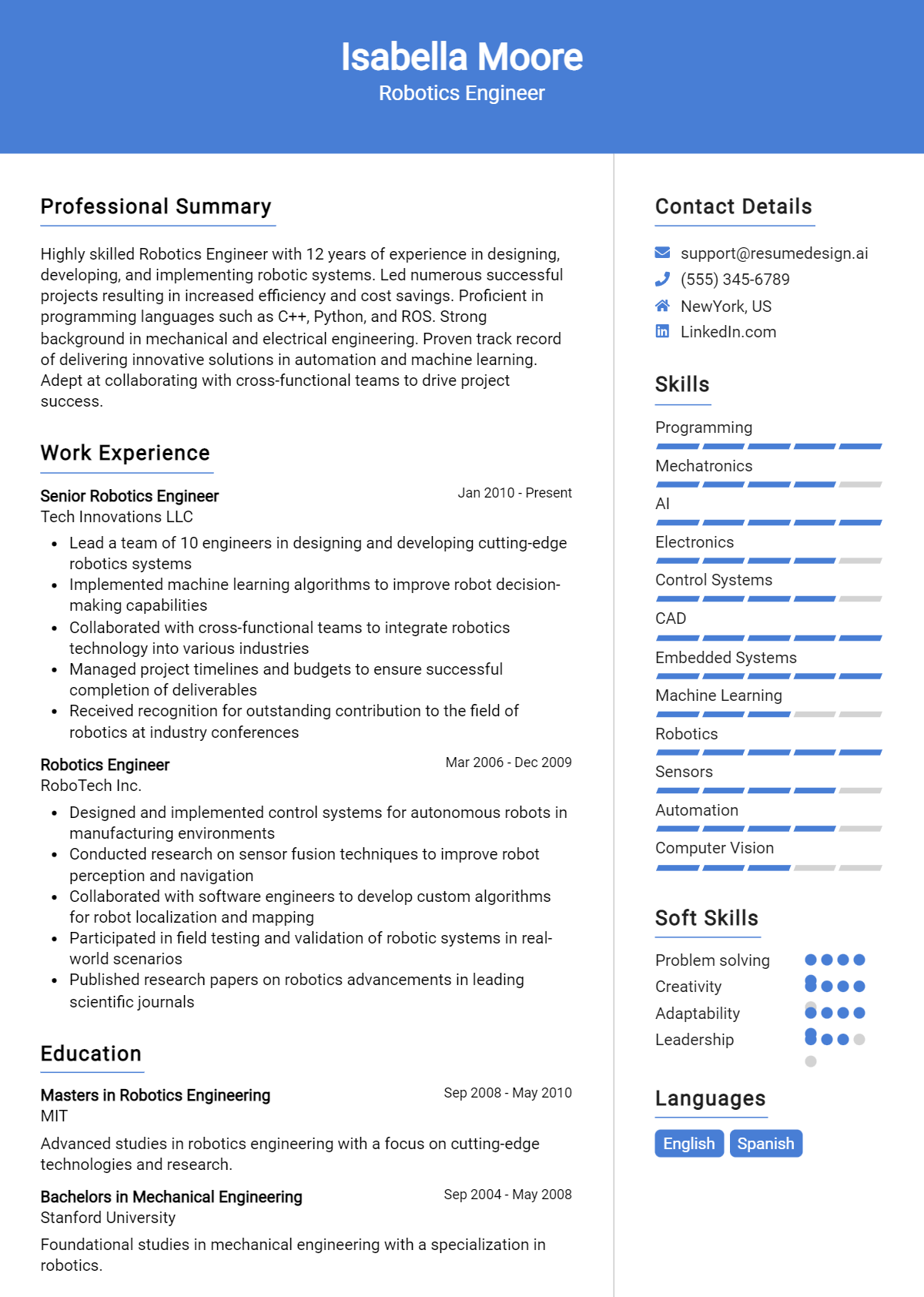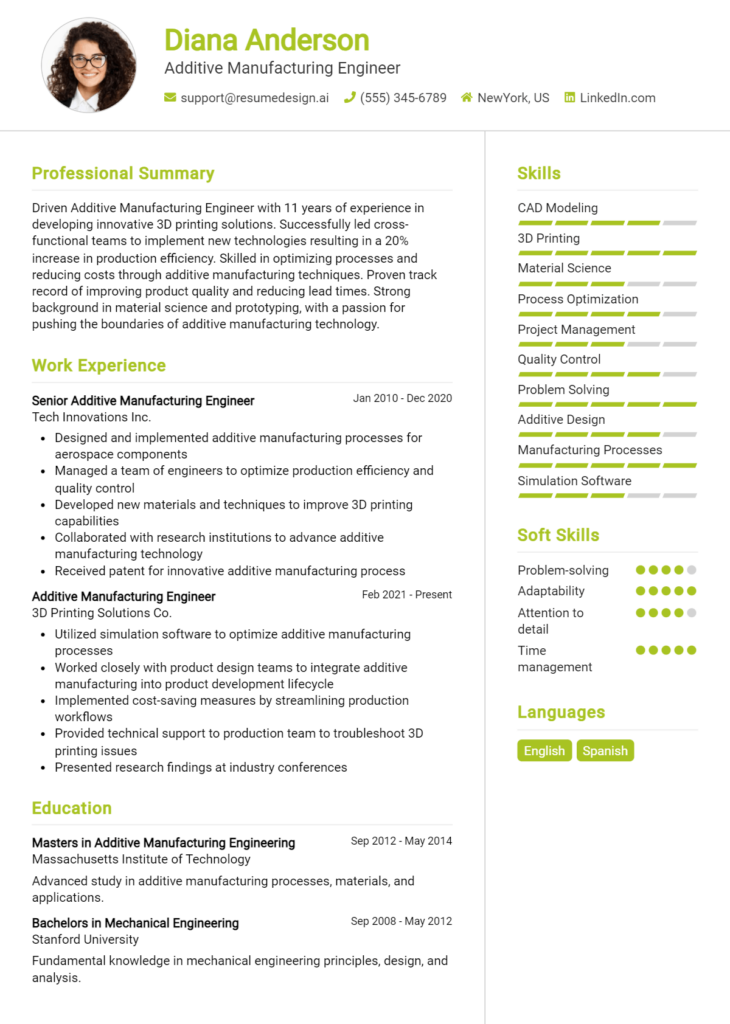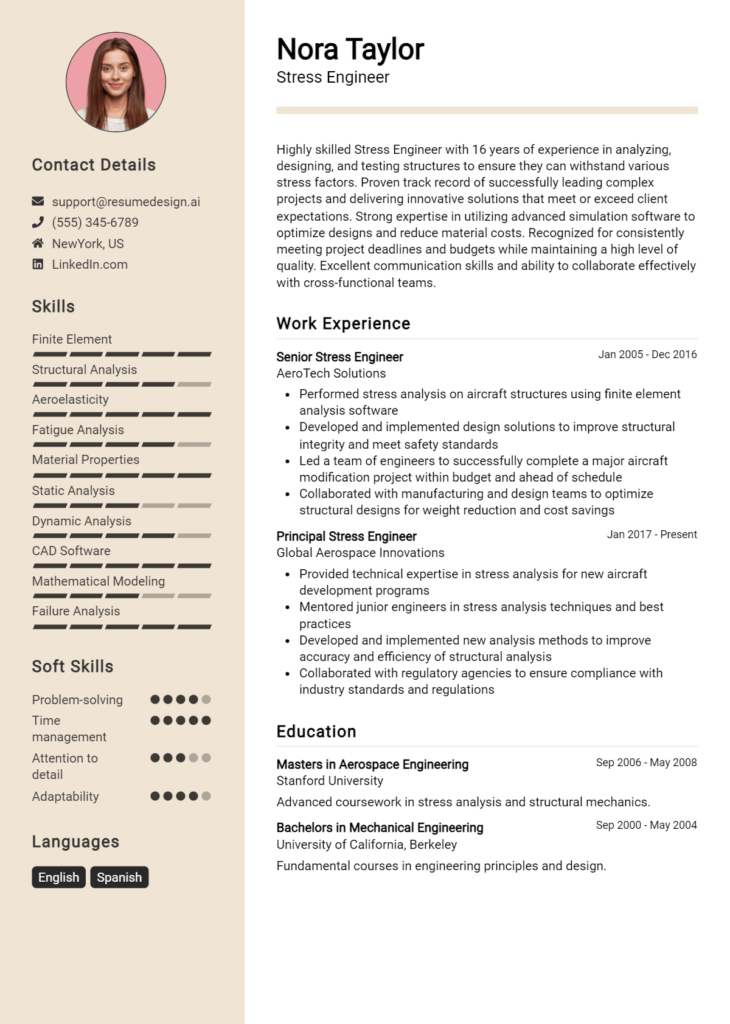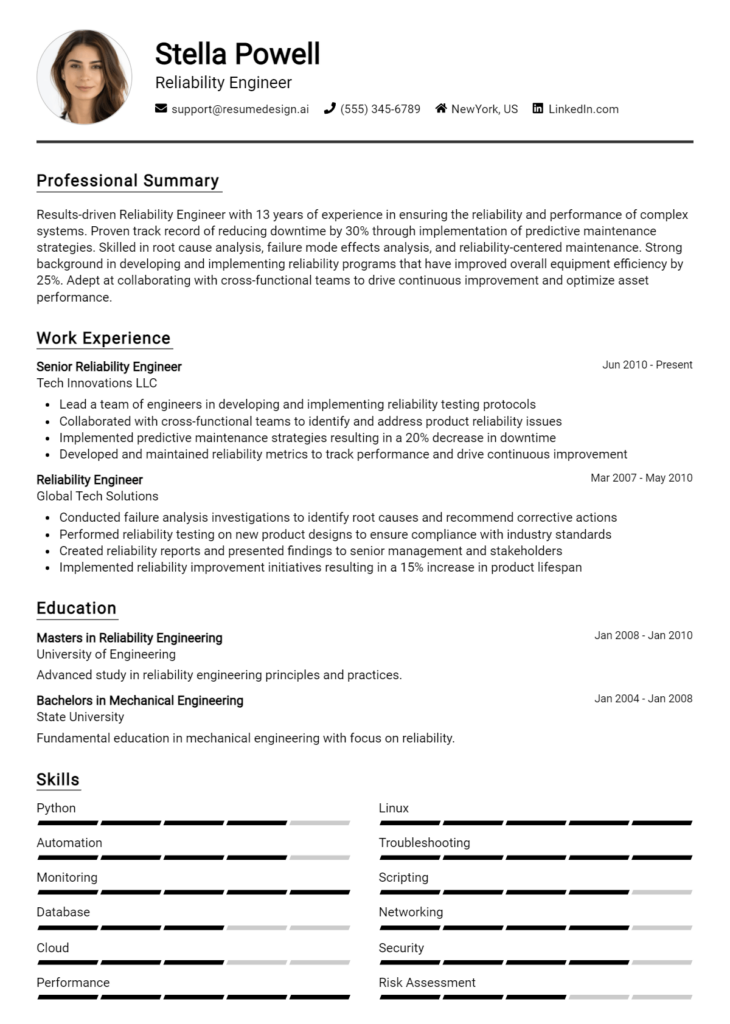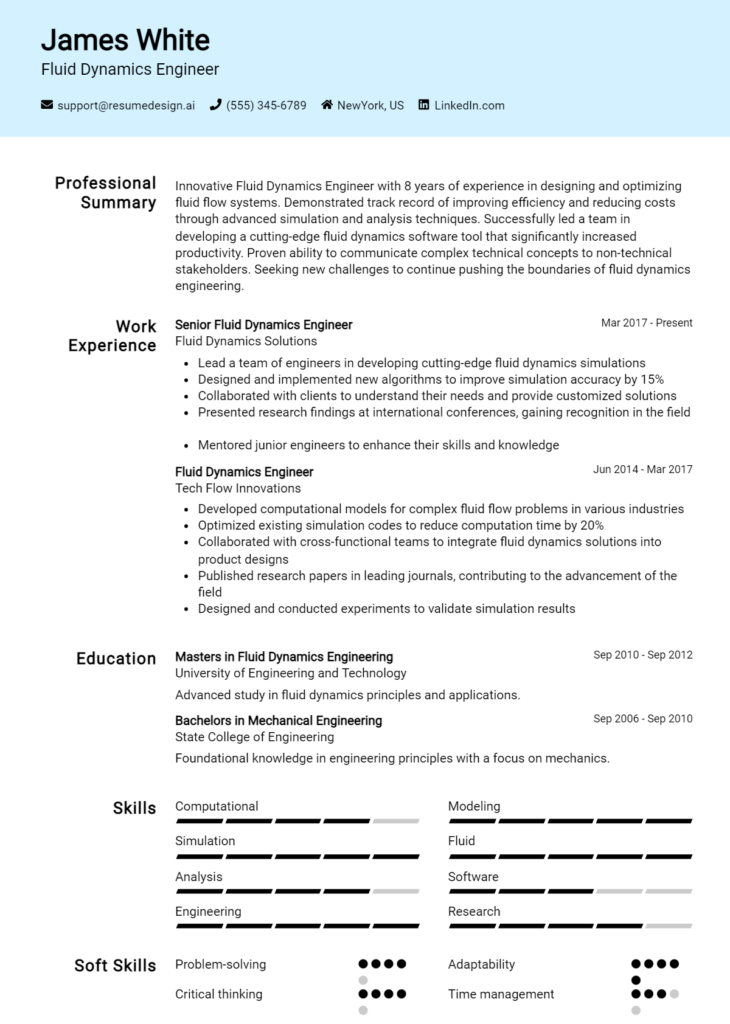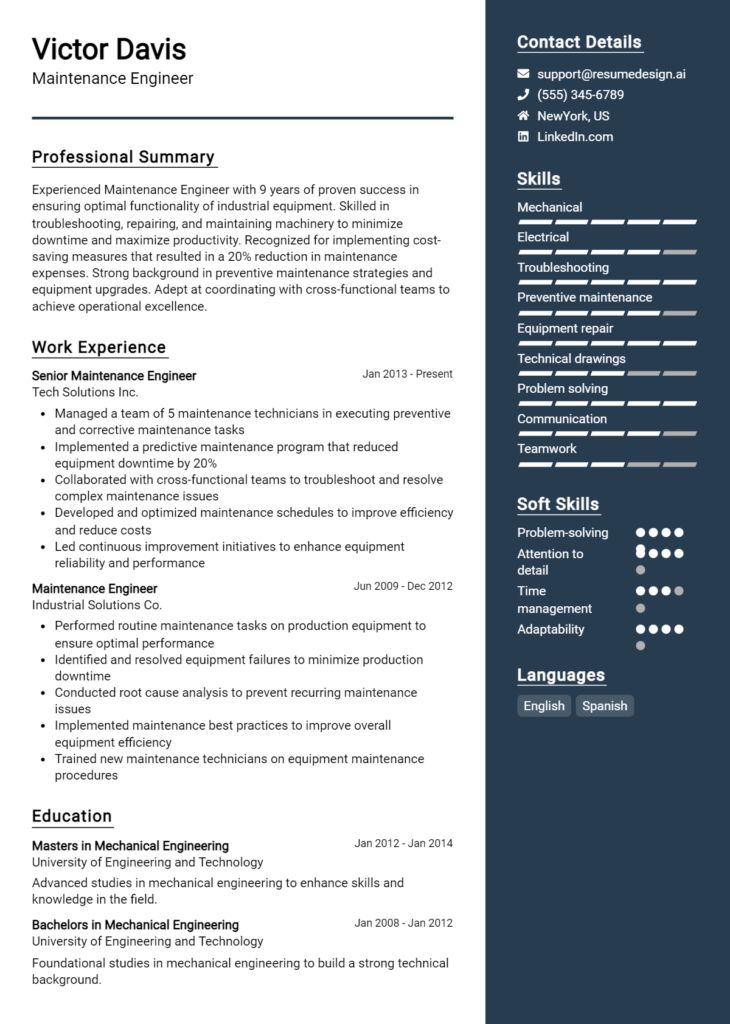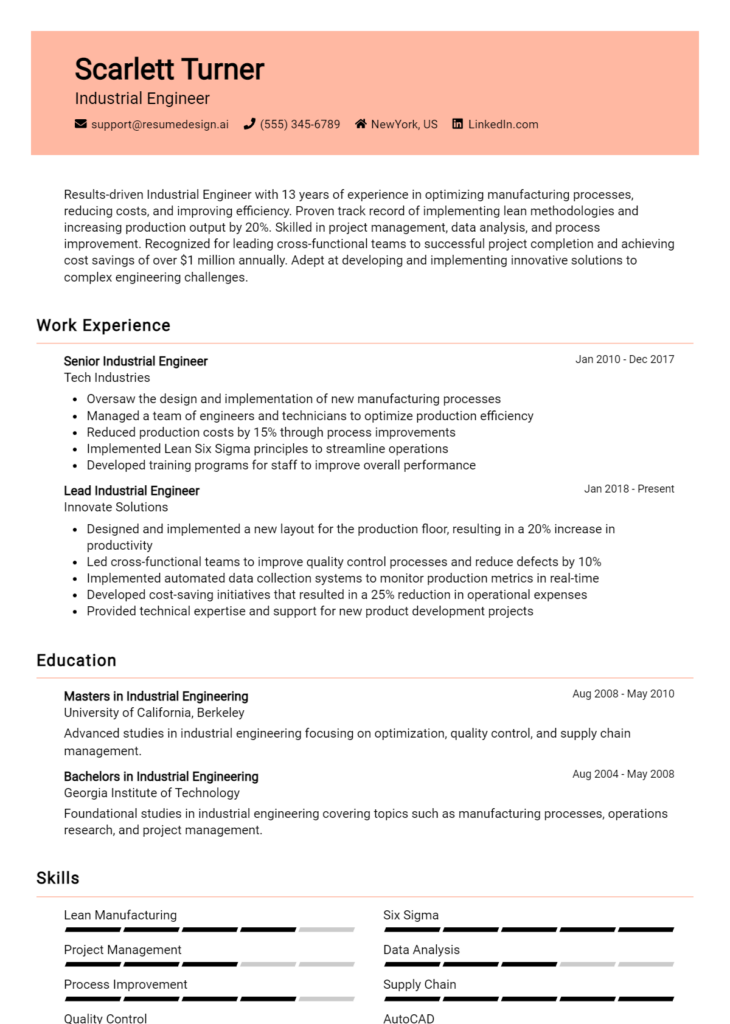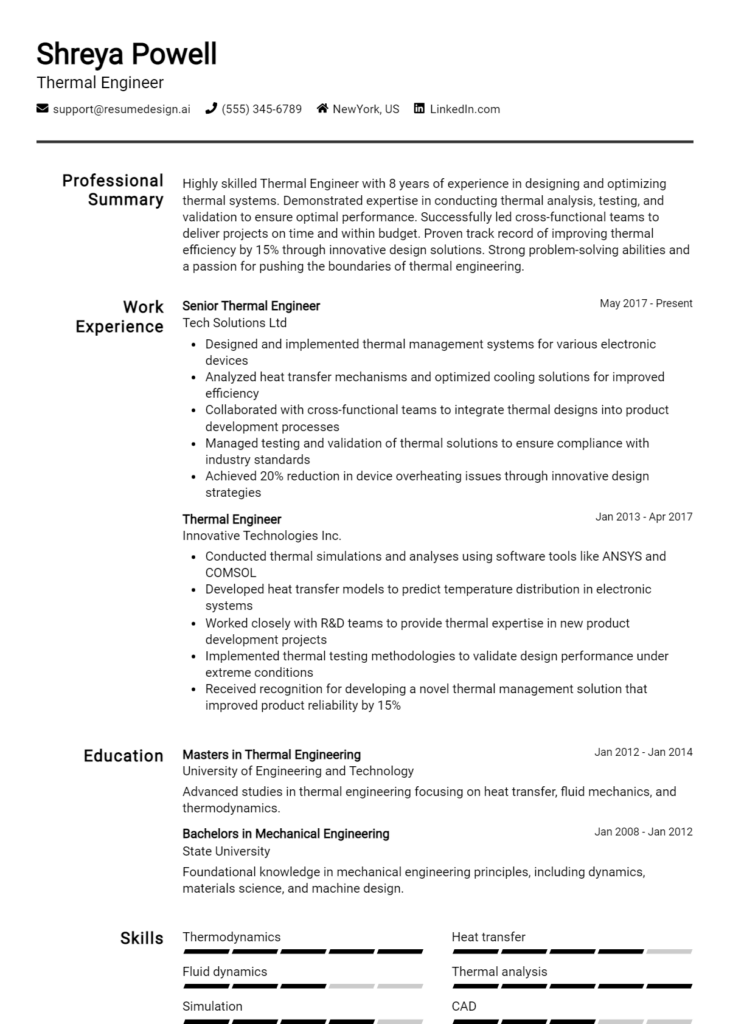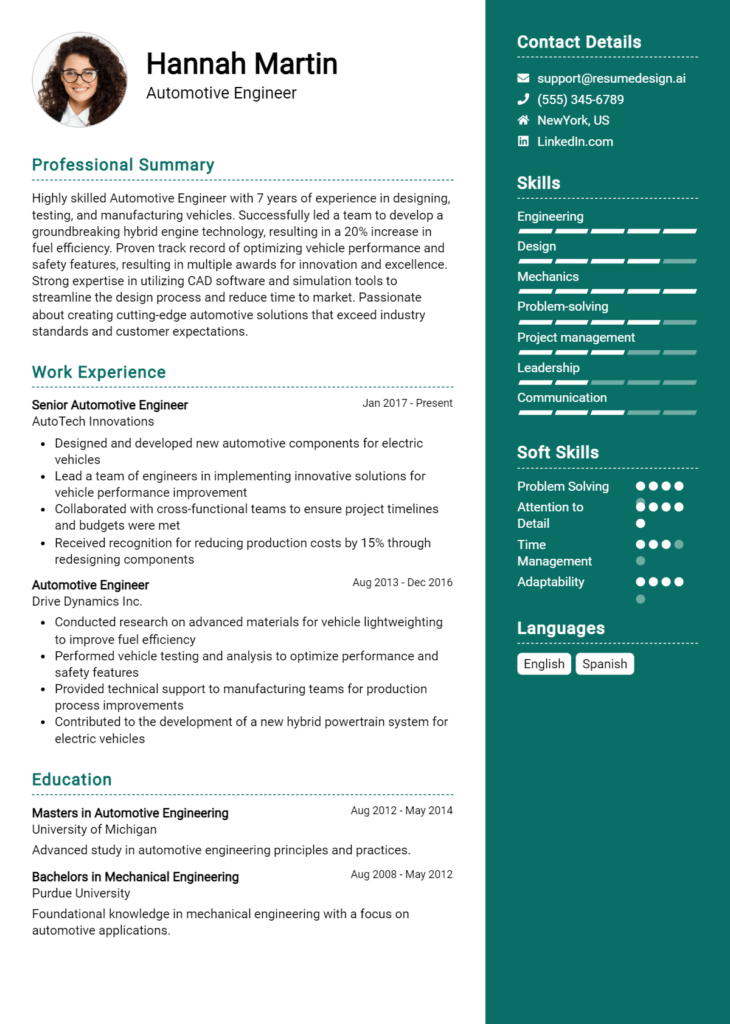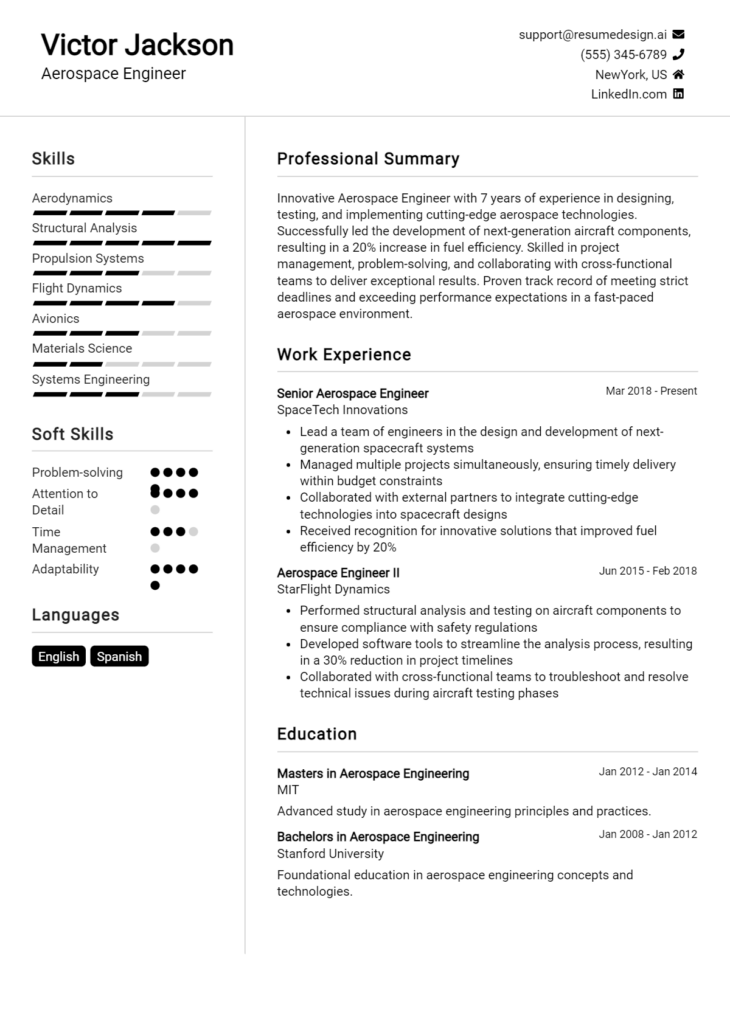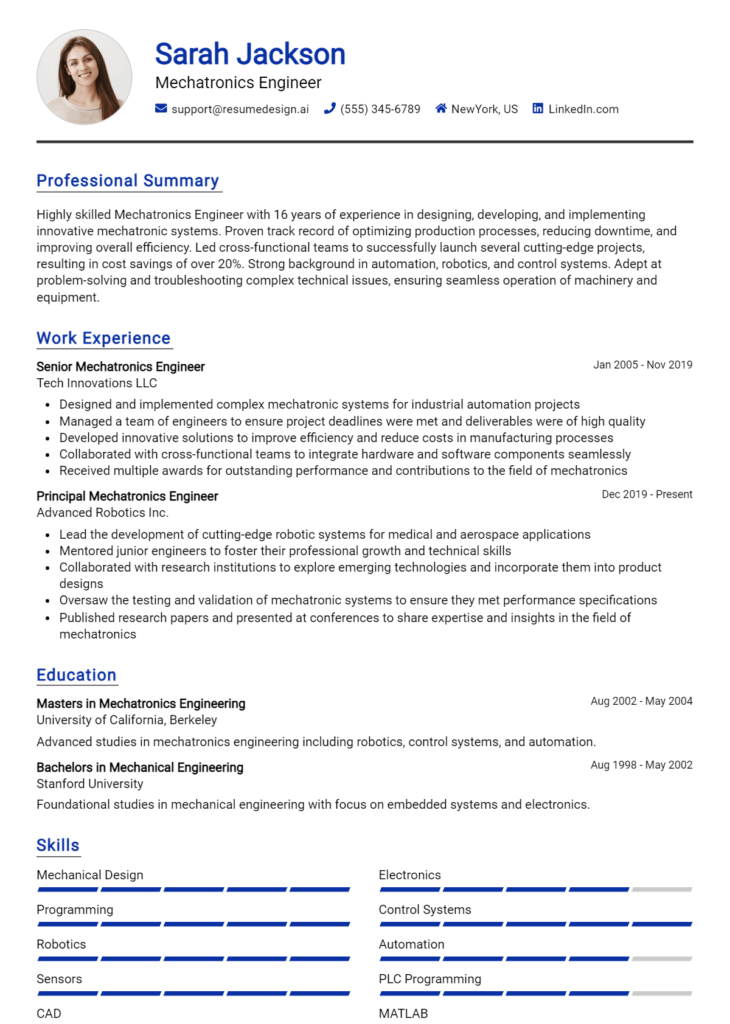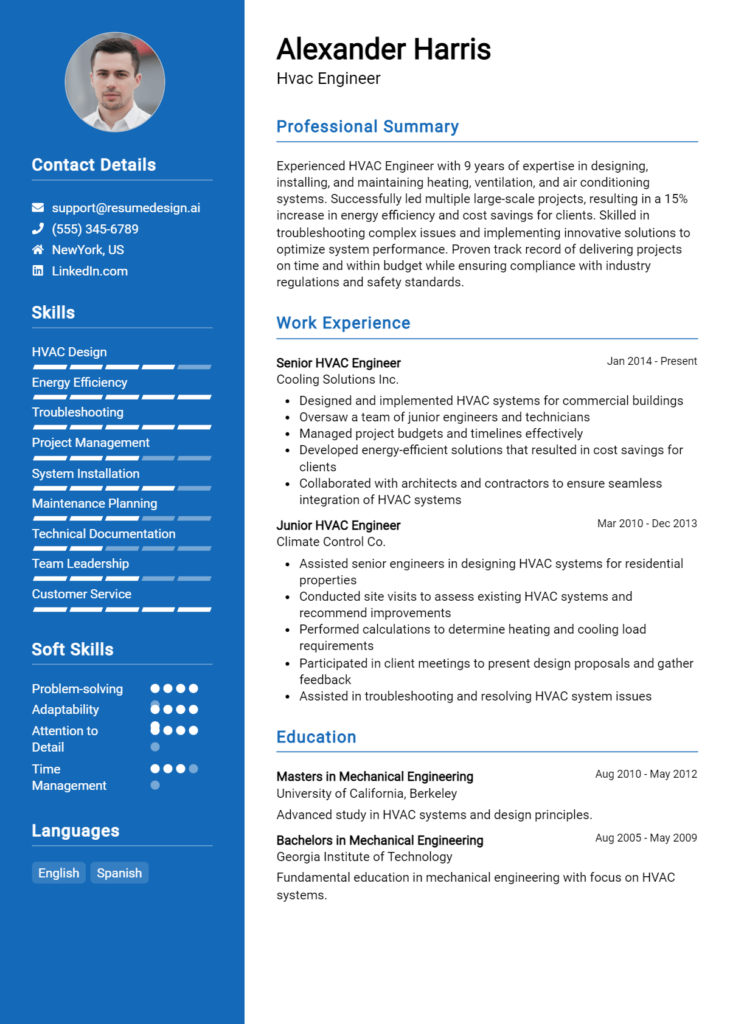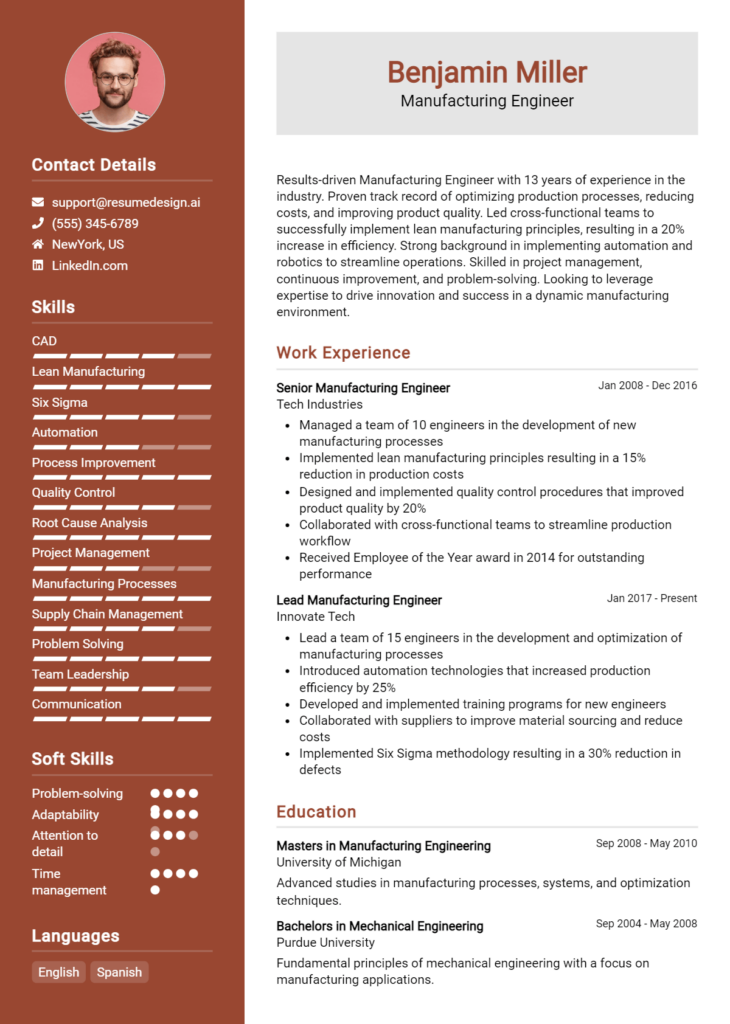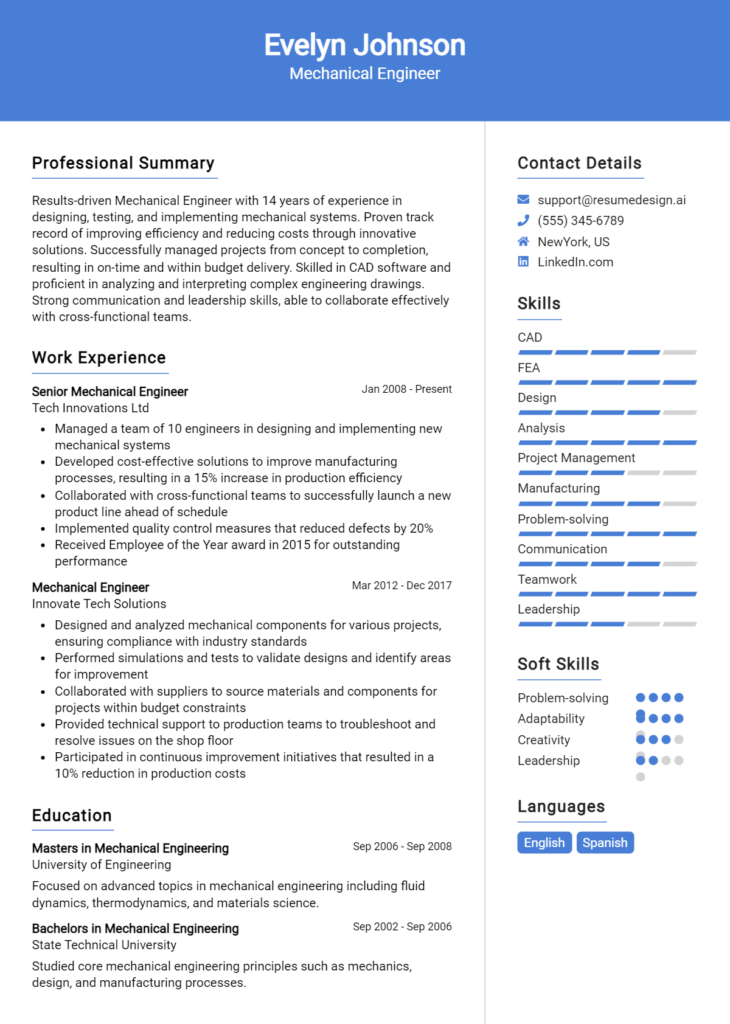Robotics Engineer Core Responsibilities
A Robotics Engineer is responsible for designing, developing, and maintaining robotic systems, requiring a blend of technical, operational, and problem-solving skills. This role often bridges various departments, including engineering, manufacturing, and quality assurance, facilitating collaboration to achieve organizational goals. Proficiency in programming, automation, and systems integration is essential, as is the ability to troubleshoot complex issues. A well-structured resume can effectively highlight these qualifications, showcasing the candidate’s potential to contribute to innovative projects and enhance productivity.
Common Responsibilities Listed on Robotics Engineer Resume
- Design and develop robotic systems and components.
- Program, test, and troubleshoot robotic applications.
- Conduct feasibility studies and cost analysis for automation projects.
- Collaborate with cross-functional teams to integrate robotics into production lines.
- Maintain and upgrade existing robotic systems for improved efficiency.
- Ensure compliance with industry standards and safety regulations.
- Document technical specifications and system performance metrics.
- Provide technical support and training to staff on robotic equipment.
- Research and implement new technologies in robotics.
- Analyze data from robotic systems to optimize performance.
- Participate in project management and planning activities.
High-Level Resume Tips for Robotics Engineer Professionals
In today's competitive job market, a well-crafted resume is crucial for Robotics Engineer professionals aiming to stand out from the crowd. Your resume is often the first impression you make on a potential employer, serving as a snapshot of your skills, achievements, and professional journey. A compelling resume not only showcases your technical expertise but also reflects your ability to contribute to innovative projects and solutions in the robotics field. This guide will provide practical and actionable resume tips specifically tailored for Robotics Engineer professionals, helping you present your qualifications in the best light possible.
Top Resume Tips for Robotics Engineer Professionals
- Tailor your resume to match the specific job description, emphasizing relevant skills and experiences that align with the job requirements.
- Highlight your hands-on experience with robotics systems, including any design, programming, and testing you’ve conducted.
- Quantify your achievements whenever possible, using metrics and statistics to demonstrate the impact of your work, such as improved efficiency or reduced costs.
- Include industry-specific skills such as programming languages (e.g., Python, C++), simulation tools (e.g., MATLAB, ROS), and hardware knowledge relevant to robotics.
- Showcase any projects or research you have led or contributed to, detailing your role and the technologies used.
- Incorporate keywords from the job posting to pass through Applicant Tracking Systems (ATS) and catch the attention of hiring managers.
- Emphasize your problem-solving abilities, especially in complex engineering challenges, by providing examples of how you've addressed them.
- List relevant certifications or licenses that enhance your qualifications, such as Certified Robotics Technician or Project Management Professional (PMP).
- Keep your resume concise and well-organized, using clear headings and bullet points to make it easy for hiring managers to scan quickly.
By implementing these tips, Robotics Engineer professionals can significantly enhance the effectiveness of their resumes, increasing their chances of landing a job in this dynamic and innovative field. A polished resume that thoughtfully highlights your achievements and skills can be the key to opening doors to exciting career opportunities in robotics.
Why Resume Headlines & Titles are Important for Robotics Engineer
In the competitive field of robotics engineering, crafting an impactful resume is crucial for standing out among a sea of qualified candidates. The headline or title of a resume serves as the first impression for hiring managers, encapsulating a candidate's core qualifications and expertise in a single, powerful phrase. A strong resume headline can instantly grab attention, showcasing a candidate's suitability for the role and encouraging further reading. It should be concise, relevant, and tailored specifically to the job being applied for, ensuring that it resonates with the requirements of the position and reflects the candidate's unique strengths.
Best Practices for Crafting Resume Headlines for Robotics Engineer
- Keep it concise: Aim for a headline that is brief yet informative, ideally no more than 10-12 words.
- Be specific: Tailor the headline to the specific job description, including relevant skills or technologies.
- Highlight key qualifications: Focus on your most impressive qualifications or accomplishments that align with the job.
- Use industry keywords: Incorporate relevant keywords from the job listing to pass through applicant tracking systems.
- Showcase experience level: Indicate whether you are an entry-level, mid-career, or senior professional.
- Make it impactful: Use action-oriented language or strong adjectives to convey confidence and expertise.
- Be authentic: Ensure that the headline reflects your true capabilities and experiences.
- Avoid jargon: Use clear and straightforward language that is accessible to all hiring managers.
Example Resume Headlines for Robotics Engineer
Strong Resume Headlines
Innovative Robotics Engineer Specializing in Autonomous Systems Development
Experienced Robotics Engineer with a Focus on Machine Learning Algorithms
Results-Driven Robotics Engineer with 5+ Years in Industrial Automation
Passionate Robotics Engineer with Expertise in Embedded Systems Design
Weak Resume Headlines
Engineer Looking for Opportunities
Robotics Professional
Entry-Level Engineer
The strong headlines are effective because they clearly convey specific skills, experiences, or areas of expertise that align with the job requirements, making an immediate impact on hiring managers. They use industry-relevant keywords and focus on the candidate's unique strengths, thus enhancing their appeal. In contrast, the weak headlines fail to impress due to their vagueness and lack of specificity, making it difficult for hiring managers to gauge the candidate's qualifications or fit for the role. By avoiding generic phrases and instead focusing on concrete abilities, candidates can significantly improve their chances of making a memorable first impression.
Writing an Exceptional Robotics Engineer Resume Summary
A resume summary is a critical component for Robotics Engineers seeking to make a strong first impression on hiring managers. It serves as a snapshot of a candidate's qualifications, emphasizing key skills, experience, and accomplishments that are directly relevant to the role. A well-crafted summary not only captures attention quickly but also sets the tone for the rest of the resume, showcasing the candidate's unique value proposition. It should be concise, impactful, and tailored to align with the specific job description, enabling hiring managers to swiftly recognize the candidate's potential fit within their organization.
Best Practices for Writing a Robotics Engineer Resume Summary
- Quantify Achievements: Use numbers and metrics to highlight the impact of your work.
- Focus on Relevant Skills: Emphasize technical skills and soft skills that are essential for the role.
- Tailor for the Job Description: Customize your summary to reflect the specific requirements and keywords of the job you are applying for.
- Highlight Industry Experience: Mention specific industries you’ve worked in, especially if they relate to robotics.
- Showcase Problem-Solving Abilities: Illustrate how you have successfully addressed challenges in past projects.
- Use Action Verbs: Start sentences with strong action verbs to convey confidence and proactivity.
- Keep it Concise: Aim for 3-5 sentences that deliver your message clearly and effectively.
- Demonstrate Passion: Infuse your summary with a sense of enthusiasm for robotics and innovation.
Example Robotics Engineer Resume Summaries
Strong Resume Summaries
Results-driven Robotics Engineer with over 5 years of experience in designing and implementing automated systems for manufacturing. Successfully led a project that improved production efficiency by 30% through innovative robotic solutions.
Detail-oriented Robotics Engineer skilled in programming and robotics design, with a proven track record of developing algorithms that enhance machine learning capabilities. Developed a robotic arm that reduced assembly time by 25%, contributing to significant cost savings.
Motivated Robotics Engineer with expertise in sensor integration and control systems. Spearheaded a team project that developed an autonomous drone, achieving a 40% increase in operational range and successfully passing all safety certifications.
Weak Resume Summaries
Experienced engineer looking for opportunities in robotics. I have worked on various projects and have some knowledge of programming.
Robotics Engineer with a passion for technology. Seeking a challenging role to utilize my skills and contribute to a team.
The examples provided illustrate the distinction between strong and weak resume summaries. Strong summaries are effective because they include specific achievements, quantifiable results, and relevant skills that directly relate to the robotics engineering field. In contrast, weak summaries lack detail and specificity, making them too vague and generic to capture the interest of hiring managers. By emphasizing accomplishments and tailoring content to align with job requirements, candidates can create a compelling narrative that enhances their chances of landing an interview.
Work Experience Section for Robotics Engineer Resume
The work experience section of a Robotics Engineer resume is a critical component that provides insight into the candidate's practical skills and experiences in the field. This section not only highlights the technical expertise required to design, develop, and implement robotic systems but also showcases the candidate's ability to manage teams and deliver high-quality products on time. By quantifying achievements and aligning past experiences with industry standards, candidates can effectively demonstrate their value to potential employers, making this section pivotal in securing interviews and job offers.
Best Practices for Robotics Engineer Work Experience
- Use specific technical terminology relevant to robotics and automation.
- Quantify achievements with metrics, such as percentage improvements or cost savings.
- Highlight leadership roles and teamwork experiences to emphasize collaboration skills.
- Detail projects that align with industry standards and technologies.
- Include relevant software and programming languages used in past roles.
- Focus on results-driven statements that showcase problem-solving abilities.
- Tailor your work experience to match the requirements of the job description.
- Use action verbs to start each bullet point, demonstrating initiative and impact.
Example Work Experiences for Robotics Engineer
Strong Experiences
- Led a team of 5 engineers in developing an autonomous robotic arm that increased production efficiency by 30% within the first quarter of deployment.
- Designed a custom machine learning algorithm that reduced error rates in robotic assembly tasks by 25%, resulting in savings of $50,000 annually.
- Collaborated with cross-functional teams to integrate robotics solutions into existing manufacturing processes, improving workflow efficiency by 40%.
- Managed a project to implement robotic process automation (RPA) in logistics, achieving a 20% reduction in operational costs within six months.
Weak Experiences
- Worked on various robotics projects without specific details or outcomes.
- Assisted in the development of robotic systems.
- Participated in team meetings for project planning.
- Used robotic tools and software occasionally.
The examples categorized as strong experiences illustrate specific achievements and quantifiable results that demonstrate the candidate’s impact within their roles. They provide clear evidence of technical leadership and collaborative efforts, showcasing a proactive approach to problem-solving. Conversely, the weak experiences lack detail, specificity, and measurable outcomes, which fail to convey the candidate's true capabilities and contributions in the field of robotics.
Education and Certifications Section for Robotics Engineer Resume
The education and certifications section of a Robotics Engineer resume is crucial for showcasing the candidate's academic foundation and professional qualifications. This section not only reflects the candidate's educational background but also highlights their commitment to continuous learning through industry-relevant certifications and specialized training. By providing relevant coursework, certifications, and any additional training, candidates can significantly enhance their credibility and demonstrate their alignment with the specific demands of the job role, making them more appealing to potential employers.
Best Practices for Robotics Engineer Education and Certifications
- Include only relevant degrees and certifications that align with the robotics field.
- List the most recent educational experience first, following a reverse chronological order.
- Highlight advanced degrees, such as a Master’s or PhD, especially if they are relevant to robotics.
- Incorporate industry-recognized certifications, such as those from IEEE or ASME.
- Detail specialized training or coursework that pertains to robotics, automation, or artificial intelligence.
- Be specific about the institution or organization that awarded the certification or degree.
- Include GPA or honors if they are particularly strong and relevant to the job application.
- Use clear and concise language to ensure easy readability and understanding of qualifications.
Example Education and Certifications for Robotics Engineer
Strong Examples
- M.S. in Robotics Engineering, University of California, Berkeley, 2021
- Certified Robotics Programmer (CRP), Robotics Certification Standards Alliance, 2022
- Relevant Coursework: Advanced Robotics, Machine Learning, Autonomous Systems
- B.S. in Mechanical Engineering, Massachusetts Institute of Technology, 2019
Weak Examples
- B.A. in English Literature, University of Texas, 2010
- Certification in Basic Computer Skills, 2015
- Outdated Robotics Certification, Robotics Institute, 2010
- High School Diploma, None specified, 2008
The strong examples are considered effective because they demonstrate relevant degrees and certifications that align with the responsibilities and skills required for a Robotics Engineer. They showcase advanced education, recognized credentials, and pertinent coursework that directly contribute to the candidate's qualifications. Conversely, the weak examples reflect outdated or irrelevant educational qualifications that do not relate to robotics, thus failing to support the candidate's suitability for the role. These examples may detract from the overall impression the candidate wishes to convey to potential employers.
Top Skills & Keywords for Robotics Engineer Resume
As a Robotics Engineer, showcasing your skills on a resume is crucial for standing out in a competitive job market. Employers are not only looking for technical expertise but also for the right blend of soft skills that demonstrate your ability to work collaboratively, problem-solve, and innovate in dynamic environments. A well-crafted resume that highlights both your hard and soft skills can effectively communicate your value and suitability for the role, ultimately increasing your chances of landing an interview. To enhance your resume, it’s vital to include a mix of specialized skills relevant to robotics, alongside interpersonal abilities that underscore your capacity to thrive in team-driven projects and complex problem-solving scenarios.
Top Hard & Soft Skills for Robotics Engineer
Soft Skills
- Problem-solving
- Team collaboration
- Communication
- Adaptability
- Creativity
- Attention to detail
- Critical thinking
- Time management
- Leadership
- Project management
- Analytical thinking
- Conflict resolution
- Decision-making
Hard Skills
- Programming languages (C++, Python, Java)
- Robotics design and simulation software (MATLAB, ROS)
- Electrical and mechanical systems knowledge
- Proficiency in CAD software (SolidWorks, AutoCAD)
- Machine learning and AI integration
- Sensor technology and application
- Control systems and automation
- Embedded systems development
- Prototype development
- Testing and validation techniques
- Familiarity with hardware and software integration
- Data analysis and visualization
- 3D printing and manufacturing processes
Incorporating these skills into your resume, along with relevant work experience, will provide a comprehensive overview of your capabilities as a Robotics Engineer and help you stand out to potential employers.
Stand Out with a Winning Robotics Engineer Cover Letter
Dear Hiring Manager,
I am writing to express my interest in the Robotics Engineer position at [Company Name] as advertised. With a Master’s degree in Robotics Engineering and over five years of hands-on experience in designing, developing, and testing robotic systems, I am excited about the opportunity to contribute to your innovative projects. My background in automation and my passion for cutting-edge technology align perfectly with the goals of your team, making me a strong candidate for this role.
During my time at [Previous Company Name], I successfully led a team in the development of an autonomous navigation system for industrial robots, which improved operational efficiency by 30%. This project required not only technical expertise in programming and system integration but also strong collaboration and problem-solving skills. I utilized tools such as ROS (Robot Operating System) and MATLAB, enabling me to streamline processes and enhance functionality. My ability to analyze complex data, coupled with my experience in machine learning algorithms, allows me to create intelligent systems that adapt to changing environments.
I am particularly drawn to the work being done at [Company Name] in the field of [specific area or project related to robotics]. I admire your commitment to advancing robotics technology and the impact it has on industries such as healthcare and manufacturing. I am eager to bring my skills in mechanical design, sensor integration, and software development to your team, contributing to groundbreaking projects that push the boundaries of what robotics can achieve.
Thank you for considering my application. I look forward to the opportunity to discuss how my experience and vision align with the innovative work at [Company Name]. I am excited about the potential to contribute to your team and help shape the future of robotics together.
Sincerely,
[Your Name]
[Your Contact Information]
[Your LinkedIn Profile or Website]
Common Mistakes to Avoid in a Robotics Engineer Resume
When crafting a resume for a Robotics Engineer position, it's essential to present your skills and experiences in a clear and impactful manner. Unfortunately, many candidates make common mistakes that can hinder their chances of landing an interview. Understanding these pitfalls can help you create a more effective resume that stands out to hiring managers in the competitive field of robotics engineering.
Vague Descriptions: Using general terms without specifics can leave hiring managers unclear about your actual experience. Instead, quantify your achievements and clearly describe your contributions to projects.
Neglecting Keywords: Failing to incorporate relevant industry keywords can result in your resume being overlooked by applicant tracking systems. Research job descriptions to identify essential terms and include them appropriately in your resume.
Ignoring Formatting: A cluttered or unprofessional format can detract from your qualifications. Use clear headings, consistent font styles, and bullet points to enhance readability and ensure your resume looks polished.
Overloading with Technical Jargon: While technical terms are relevant, excessive jargon can alienate readers who may not be familiar with all the terminology. Strive for a balance that communicates your technical expertise without overwhelming the reader.
Lack of Tailoring: Sending out the same generic resume for multiple positions is a missed opportunity. Customize your resume for each application to highlight the skills and experiences most relevant to the specific job.
Omitting Soft Skills: Focusing solely on technical skills can give an incomplete picture of your qualifications. Highlighting soft skills, such as teamwork, communication, and problem-solving, can demonstrate your ability to work effectively in a collaborative environment.
Inadequate Project Details: Failing to provide context for projects you've worked on can leave your accomplishments sounding hollow. Include information about the project's goals, your specific role, and the outcomes to showcase your impact.
Lengthy Resumes: A lengthy resume can overwhelm employers, leading them to overlook key information. Aim for a concise layout, ideally one page, to ensure your most important qualifications capture attention quickly.
Conclusion
As we explored the dynamic and multifaceted role of a Robotics Engineer, we highlighted essential skills such as programming, mechanical design, and system integration. The demand for Robotics Engineers continues to grow across various industries, driven by advancements in automation and artificial intelligence. We also discussed the importance of continuous learning and staying updated with the latest technologies to remain competitive in this evolving field.
To position yourself effectively in the job market, it’s crucial to have a standout resume that reflects your expertise and accomplishments. Take the time to review your Robotics Engineer resume and ensure it clearly showcases your skills, projects, and relevant experiences.
To assist you in crafting an impressive resume, consider utilizing the following tools:
- Resume Templates: Choose from a variety of professional designs tailored specifically for engineering roles.
- Resume Builder: Create a polished resume quickly and easily with a user-friendly interface that guides you through the process.
- Resume Examples: Gain inspiration from successful Robotics Engineer resumes that have captured the attention of employers.
- Cover Letter Templates: Complement your resume with a compelling cover letter that highlights your passion for robotics and your career aspirations.
Take action today—review your resume and make sure it aligns with your career goals in robotics engineering. The right tools are at your fingertips to help you make a lasting impression!

